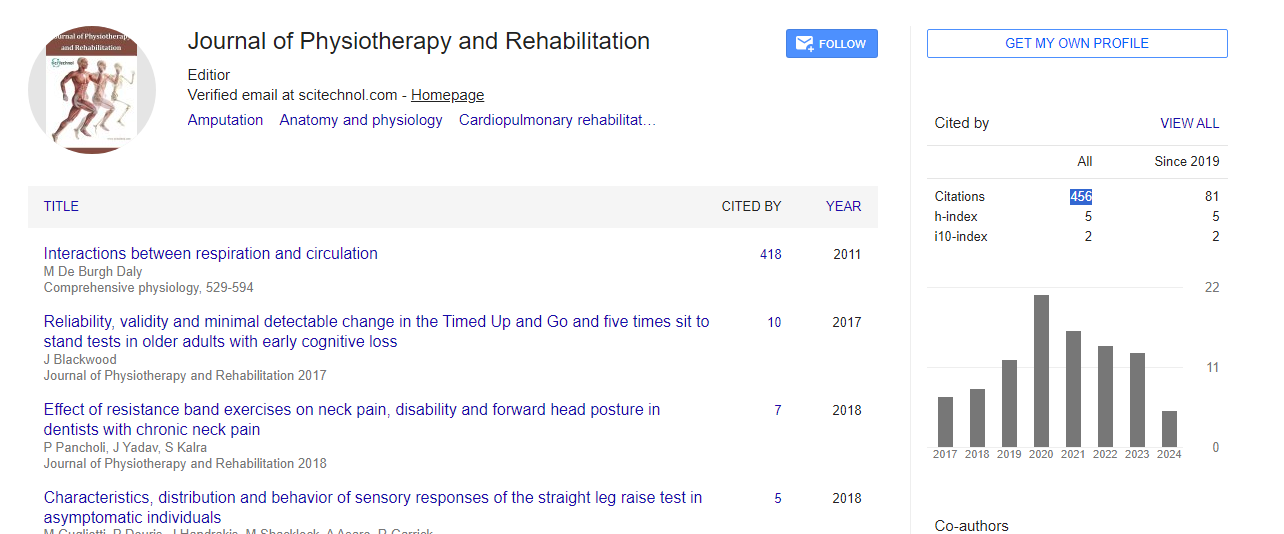Opinion Article, J Physiother Rehabi Vol: 7 Issue: 2
Optimizing Rehabilitation Outcomes with Biomechanics
Mintaz Douglas*
Department of Health Professions and Rehabilitation Sciences, University of Southampton, Highfield, Southampton, United Kingdom
*Corresponding Author: Mintaz Douglas
Department of Health Professions and Rehabilitation Sciences, University of Southampton, Highfield, Southampton, United Kingdom
E-mail: mintdoug@soton.ac.uk
Received date: 22 March, 2023, Manuscript No. JPTR-23-99184;
Editor assigned date: 24 March, 2023, Pre QC. JPTR-23-99184 (PQ);
Reviewed date: 15 April, 2023, QC No. JPTR-23-99184;
Revised date: 22 April, 2023, Manuscript No. JPTR-23-99184 (R);
Published date: 28 April, 2023, DOI: 10.4172/JPTR.1000125
Citation: Douglas M (2023) Optimizing Rehabilitation Outcomes with Biomechanics. J Physiother Rehabi 7:2.
Description
Injury prevention and rehabilitation are important components of sports and physical activity. Injuries can cause severe pain and discomfort, and they can also prevent an individual from participating in activities that they enjoy. Biomechanics can help to prevent injuries and improve rehabilitation outcomes. Biomechanics is the field of mechanics of the human body, including the interaction between muscles, bones, and joints.
Understanding biomechanics
Biomechanics is the study of the mechanical principles that govern the movements and structures of living organisms. It combines principles from physics, engineering, and biology to understand how living systems move and function, and how external forces affect them. Biomechanics can be applied to a variety of fields, including sports, medicine, physical therapy, and rehabilitation. It can be used to analyze and improve movement patterns, prevent injuries, design and develop prosthetics and assistive devices, and optimize performance in athletes.
Injury prevention using biomechanics
Injuries can occur when an individual performs a movement that exceeds the capacity of their tissues. Biomechanics can help to prevent injuries by identifying movements that are more likely to cause damage. For example, a biomechanical analysis of a golf swing can identify any movements that place excessive stress on the back or knees. This information can then be used to modify the technique to reduce the risk of injury.
Biomechanics can also be used to assess the risk of injury in athletes. This is particularly important in sports that involve highimpact movements, such as jumping or running. By analyzing an athlete's movement patterns, a biomechanist can identify any areas of weakness or instability. This information can then be used to develop a personalized injury prevention program that targets the specific needs of the athlete.
Rehabilitation using biomechanics
Injuries are a common occurrence in sports and physical activity. Rehabilitation is an essential part of the recovery process. Biomechanics can be used to aid in the rehabilitation process by identifying any imbalances or weaknesses that may be contributing to the injury. For example, a biomechanical analysis of a runner with knee pain may reveal an imbalance in the strength of their quadriceps muscles. This information can then be used to develop a rehabilitation program that targets the specific weakness.
Biomechanics can also be used to monitor an individual's progress during the rehabilitation process. By analyzing an individual's movement patterns, a bio mechanist can assess their progress and make any necessary adjustments to the rehabilitation program. This can help to ensure that the individual is making progress towards their rehabilitation goals.
Conclusion
Biomechanics is an essential tool for injury prevention and rehabilitation. By analyzing an individual's movement patterns, a biomechanist can identify any imbalances or weaknesses that may be contributing to the injury. This information can then be used to develop a personalized injury prevention or rehabilitation program that targets the specific needs of the individual. Biomechanics can also be used to monitor an individual's progress during the rehabilitation process, ensuring that they are making progress towards their rehabilitation goals. As such, it is difficult to the individuals, coaches, and healthcare professionals incorporate biomechanics into their injury prevention and rehabilitation strategies.
 Spanish
Spanish  Chinese
Chinese  Russian
Russian  German
German  French
French  Japanese
Japanese  Portuguese
Portuguese  Hindi
Hindi 